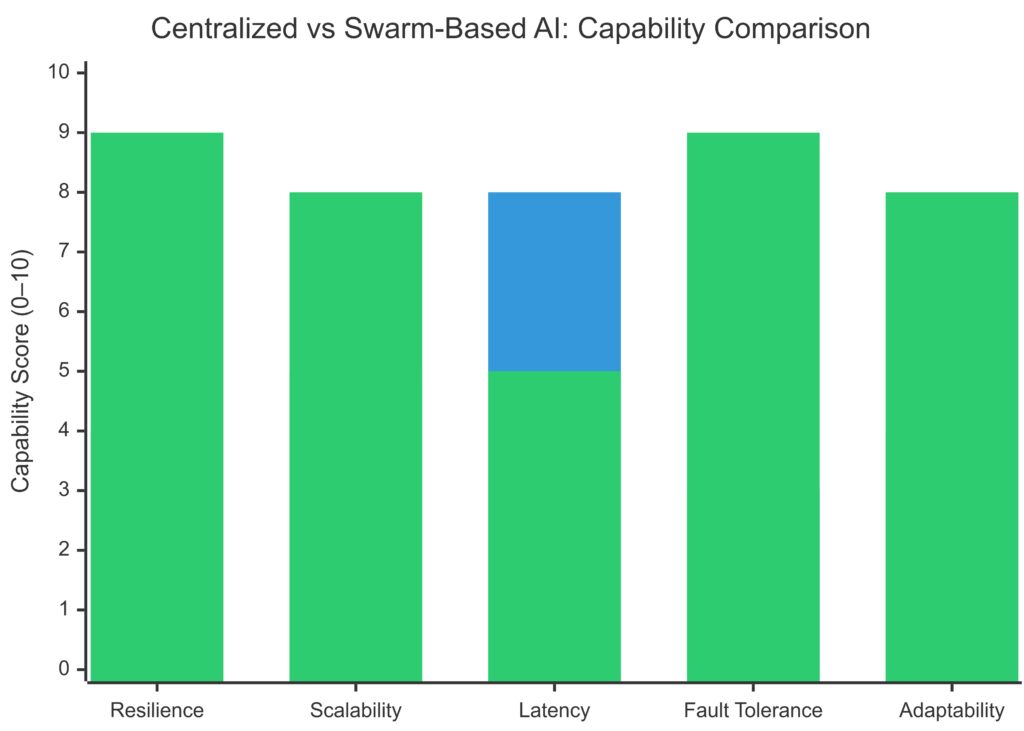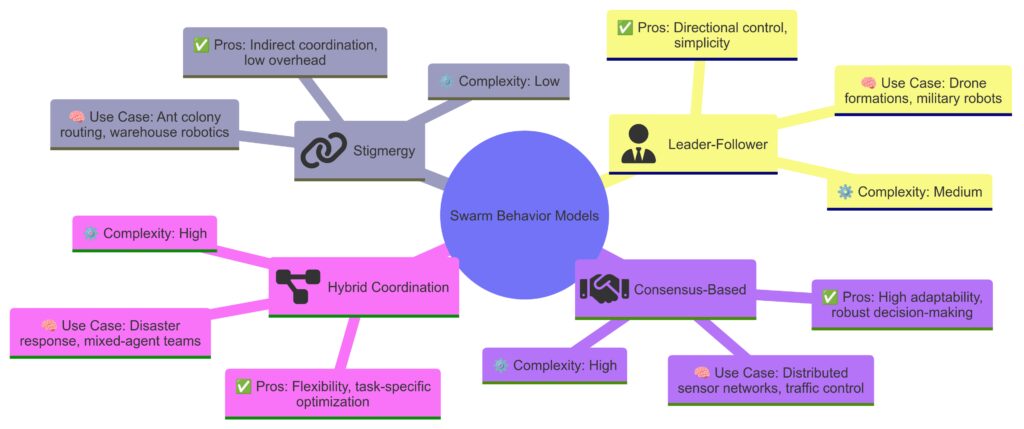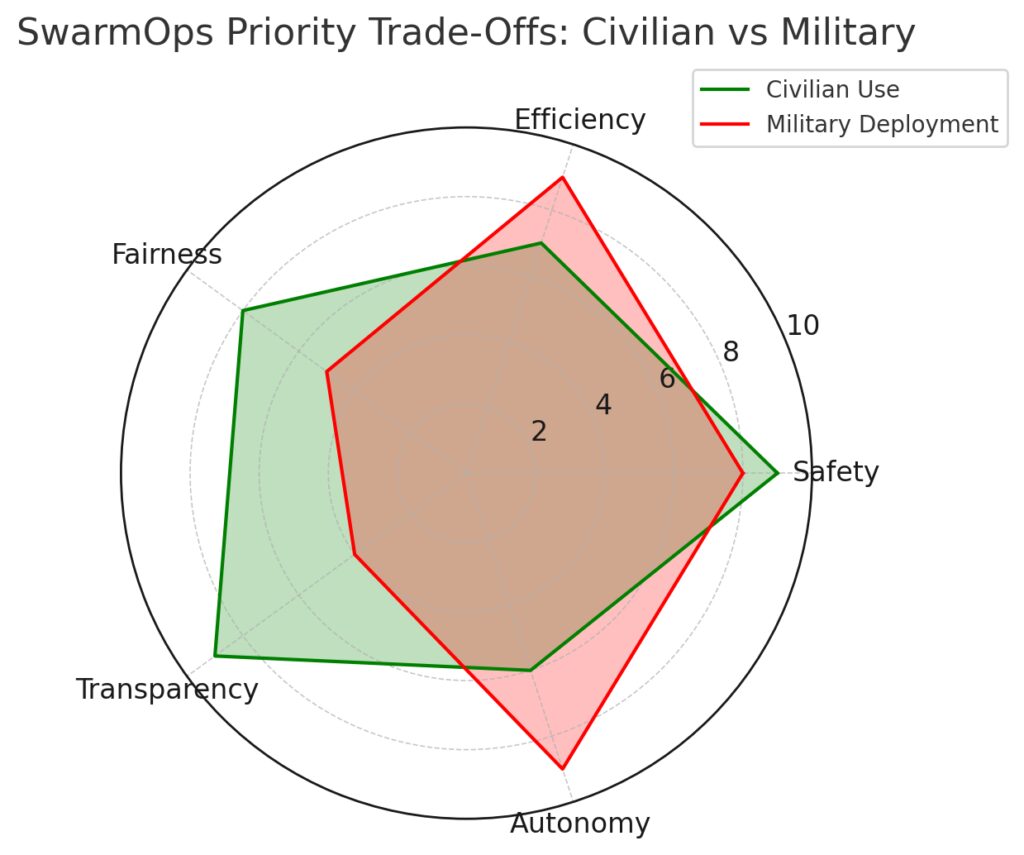
What Is SwarmOps and Why It Matters
A New Frontier in AI System Design
SwarmOps is the emerging practice of managing and optimizing multi-agent AI systems. Think of it as the mission control for swarms of intelligent agents working together.
These agents could be physical robots, software bots, or hybrid systems. What makes SwarmOps essential is its role in coordinating these agents to act harmoniously, with minimal human intervention.
It’s not just about automation. It’s about collaboration at scale.
From Isolated Intelligence to Collective Behavior
Traditional AI focuses on training a single model for a specific task. SwarmOps changes the game. It enables diverse AI agents to learn, adapt, and solve problems together—often in real time.
Whether it’s autonomous drones surveying a disaster zone or software agents managing cloud infrastructure, SwarmOps ensures they’re not stepping on each other’s toes.
Core Principles Behind Multi-Agent Orchestration

Autonomy with a Purpose
Each agent in a swarm has a goal, but also a shared mission. SwarmOps orchestrates these goals without micromanaging every move.
It emphasizes:
- Decentralized control
- Local decision-making
- Global coordination
The balance between autonomy and alignment is delicate—and crucial.
Communication Is Key
SwarmOps leverages structured messaging systems and protocols so agents can talk, listen, and react effectively. It’s less about chatting, more about efficient, intention-driven signaling.
Reliable, low-latency communication makes the magic happen.
Why SwarmOps Beats Centralized AI Models

Performance comparison between centralized models and decentralized multi-agent AI systems
Resilience and Scalability
If one agent fails, the swarm adapts. That’s a huge advantage over centralized systems.
SwarmOps delivers:
- Fault tolerance by design
- Massive scalability across environments
- Load balancing via distributed execution
It’s like comparing a single-threaded app to a cloud-native microservice architecture. More agents, less fragility.
Real-Time Adaptation
Centralized systems often hit bottlenecks. In contrast, swarm-based systems can shift strategies mid-operation.
SwarmOps lets agents pivot based on local conditions—without waiting for orders.
Challenges in Multi-Agent System Management
Complexity at Every Level
More agents mean more variables. Designing policies that prevent chaotic behavior takes serious finesse.
From behavioral modeling to failure scenarios, managing a swarm can feel like trying to herd digital cats—unless you’ve got the right framework.
Communication Overhead
Too much chatter, and systems slow down. Too little, and coordination breaks.
SwarmOps has to optimize communication layers to balance:
- Bandwidth usage
- Latency
- Agent priorities
That’s why efficient message-passing protocols and decision heuristics are critical.
Did You Know?
NASA and DARPA are already deploying swarm strategies in space missions and battlefield simulations. These systems outperform centralized AI in dynamic environments.
Real-World Examples of SwarmOps in Action
Drones, Bots, and Autonomous Fleets
From package delivery drones to robot warehouse pickers, swarms are getting real.
Companies like Zipline, Amazon, and Boston Dynamics are integrating SwarmOps principles to scale operations and reduce downtime.
Each drone or bot isn’t just acting smart—it’s acting smart together.
Finance and Cybersecurity
In high-frequency trading or threat detection, swarms of AI agents can react in milliseconds to evolving scenarios. SwarmOps lets them maintain collective focus, even in high-noise data streams.
It’s like giving each AI agent a role in a cyber-defense orchestra.
SwarmOps Architecture: Building Blocks That Scale
Modular, Decentralized Design
A solid SwarmOps system starts with a modular architecture. Each agent functions as a self-contained unit—autonomous, but not isolated.
This design allows agents to:
- React independently to stimuli
- Share discoveries with peers
- Scale without bottlenecks
It’s like creating a colony of intelligent ants—simple on their own, powerful together.
Layered System Design
SwarmOps systems often follow a layered architecture, including:
- Perception Layer for sensory input
- Decision Layer for local reasoning
- Coordination Layer for swarm-wide strategy
This structure keeps complexity manageable and supports fault tolerance at each level.
Popular Frameworks and Toolkits for SwarmOps
ROS, Webots, and Beyond
The Robot Operating System (ROS) is a go-to for managing hardware swarms. It handles real-time communication, sensing, and control.
For simulations, tools like Webots and Gazebo allow teams to test swarm logic in rich, virtual environments before deployment.
In software-only swarms, libraries like Ray and PettingZoo are gaining traction for distributed agent management and training.
Agent-Based Modeling Libraries
Want fine-grained control over agent behavior? Tools like:
- Mesa (Python)
- JADE (Java)
- Unity ML-Agents
These allow you to script and simulate complex agent dynamics—ideal for swarm behavior prototyping.
Key Design Patterns in Swarm Behavior

Stigmergy and Leader-Follower Models
Stigmergy is a fascinating design pattern where agents leave signals in the environment (like ants with pheromones). Other agents respond without direct communication.
Meanwhile, leader-follower models offer simplicity: one or more agents set the direction, and others follow while adjusting locally.
These patterns reduce system overhead while maintaining emergent coordination.
Behavior Trees and Finite State Machines
To make agent logic transparent and flexible, SwarmOps often uses:
- Behavior Trees: Easy to debug and prioritize actions
- Finite State Machines: Lightweight for real-time decisions
Mixing these with reinforcement learning creates robust hybrid agents that learn and adapt within predefined bounds.
Key Takeaways
- Decentralized, layered architecture is crucial for robust swarm behavior.
- Use simulation tools like Webots and Gazebo to test before real-world deployment.
- Behavioral patterns like stigmergy reduce communication needs while boosting emergent intelligence.
SwarmOps and Reinforcement Learning Integration

The Rise of Multi-Agent Reinforcement Learning (MARL)
Reinforcement learning (RL) is even more powerful when multiple agents learn together. Enter MARL—a natural fit for SwarmOps.
Each agent gets a reward signal, but the system must align these toward a shared objective. That’s the challenge MARL is designed to solve.
Centralized Training, Decentralized Execution
This is a popular trick in SwarmOps RL. During training, agents can share everything. During execution, they rely only on local data.
It’s like sending a football team to training camp—then letting each player handle their position during the game.
Example Use Cases
- Autonomous vehicles coordinating on the road
- Trading agents learning not to cannibalize each other’s strategies
- AI avatars in games collaborating for more lifelike behavior
SwarmOps provides the scaffolding that keeps MARL systems coherent and safe.
Security, Ethics, and Failure Management

Ethical and operational trade-offs in different SwarmOps deployment scenarios
Trusting the Swarm
With great autonomy comes great risk. What happens when a few agents go rogue or get hacked?
SwarmOps integrates:
- Trust metrics for agent behavior
- Fallback protocols for system-wide shutdowns
- Authentication and encryption in all communications
Security can’t be an afterthought—it has to be designed in.
Ethical Design Choices
Should swarms prioritize speed or human safety? Efficiency or fairness?
SwarmOps architects often need to hard-code ethical priorities into agents, or let reinforcement learning tune the balance.
There’s no one-size-fits-all answer—but the questions matter.
Future-Proofing the Swarm
We’ve unpacked the current tools and patterns—but where’s this all going? Next up: we explore future trends, AI governance in swarms, and how SwarmOps may power the next AI revolution.
Future Trends in SwarmOps & Multi-Agent AI
From Simulation to Real-World Autonomy
As hardware improves, more swarms are escaping the lab and entering the wild. Expect to see:
- Drone flocks for agriculture and mapping
- Swarm robots in construction and disaster relief
- AI fleet managers overseeing autonomous delivery networks
These aren’t isolated projects anymore—they’re ecosystem shifts.
Edge AI and Swarm Decentralization
The rise of Edge AI means less reliance on cloud infrastructure. Swarm agents can process data, make decisions, and act—all locally.
This reduces latency and network load, and increases resilience in harsh or disconnected environments.
SwarmOps must evolve to support these decentralized execution models with stronger local autonomy logic.
Future Outlook
AI swarms will become foundational infrastructure. They’ll silently coordinate logistics, monitor environments, and manage digital systems—without constant human oversight.
This shift will require robust SwarmOps frameworks that are:
- Self-healing
- Transparent
- Globally adaptive
AI Governance in Swarm Systems
Swarms Need Rules, Too
You wouldn’t run a country without laws. The same goes for autonomous swarms.
SwarmOps is expanding to include governance frameworks that enforce safety limits, transparency, and ethical compliance.
These might include:
- Behavior auditing systems
- Automated ethics filters
- Override protocols for human intervention
As swarms gain power, accountability becomes non-negotiable.
Explainability and Transparency
Can a swarm explain why it did what it did?
SwarmOps must make agent decisions auditable and interpretable. This is essential for trust—especially in finance, healthcare, and public safety.
Emerging tools like policy visualizers and decision tree extractors are part of this movement toward AI explainability.
Cross-Disciplinary Impact: Beyond AI
Merging SwarmOps with IoT, Blockchain, and Bio-Inspired Tech
SwarmOps is no longer a pure AI concern.
It’s blending with:
- IoT for smart cities and sensor networks
- Blockchain for secure, trustless coordination
- Bio-inspired computation for adaptive evolution
These integrations unlock possibilities like autonomous microgrids, adaptive building management systems, and even self-organizing traffic systems.
SwarmOps is becoming a glue between digital and physical complexity.
Human-Swarm Collaboration
Imagine a future where you don’t give commands—you set intentions.
SwarmOps is heading toward interfaces where humans act more like strategic conductors, guiding AI symphonies through gesture, voice, or real-time dashboards.
The goal? Augment human decision-making, not replace it.
Did You Know?
MIT is developing neural-inspired algorithms that let AI agents “vote” on the best course of action. It’s swarm democracy in action—designed to prevent single-agent dominance or blind groupthink.
Building SwarmOps Talent and Culture
The Skills You Need
SwarmOps requires a unique blend of:
- Systems engineering
- AI modeling
- Behavioral psychology
- Distributed computing
As it becomes a mainstream discipline, expect dedicated certifications and academic programs to emerge.
Open-Source and Community-Driven Growth
Open-source is fueling SwarmOps innovation. Projects like HiveMind, Ray, and MARLlib are creating shared knowledge bases that grow faster than any single company can.
Jumping into SwarmOps now means joining a movement, not just learning a skillset.
Expert Opinions on SwarmOps and Multi-Agent AI Systems
Advocates for Decentralized AI Collaboration
Many AI researchers and practitioners champion the decentralized nature of multi-agent systems. They argue that distributing intelligence across numerous agents enhances scalability, resilience, and adaptability. For instance, OpenAI’s experimental “Swarm” framework has been highlighted as a tool that facilitates lightweight coordination among AI agents, promoting efficient task delegation and collaboration. Medium
Skepticism Towards Multi-Agent Complexity
Conversely, some experts express reservations about the complexity inherent in orchestrating multiple AI agents. Discussions on platforms like Hacker News reveal concerns that building complex agent systems may be less efficient than refining single, more powerful models. Critics argue that managing interactions between numerous agents can introduce unnecessary complications without guaranteeing superior performance. Hacker News
Debates and Controversies in Multi-Agent AI
Centralized Models vs. Agent Swarms
A significant debate centers on the efficacy of centralized AI models compared to distributed agent swarms. Proponents of centralized models argue that a singular, robust AI can handle tasks more effectively than a network of smaller agents. In contrast, supporters of swarm intelligence contend that multiple specialized agents can collaboratively address complex problems more efficiently, drawing parallels to natural systems like ant colonies or bee hives. Medium
Ethical and Security Concerns
The deployment of multi-agent systems raises ethical and security questions. The potential for autonomous agents to operate without human oversight necessitates discussions about accountability, decision-making transparency, and fail-safes to prevent unintended consequences. Moreover, the risk of malicious exploitation of such systems underscores the need for robust security measures.
Journalistic Perspectives on SwarmOps
Media Coverage of OpenAI’s Swarm Framework
The unveiling of OpenAI’s “Swarm” framework has garnered attention from various media outlets. VentureBeat, for example, discussed how this experimental tool has ignited debates on AI-driven automation, highlighting both its potential and the ethical considerations it brings to the forefront. Medium
Emphasis on Practical Applications
Journalists have also focused on the practical applications of multi-agent systems. Articles in Forbes explore how these systems can revolutionize industries by enabling AI agents to collaborate on tasks ranging from financial analysis to customer service, emphasizing the transformative potential of coordinated AI efforts. Forbes
Case Studies: Real-World Implementations
Financial Analysis Automation
A notable case study involves the development of an earnings report analysis agent using OpenAI’s Swarm framework. This system automates the summarization and sentiment analysis of financial reports, demonstrating the practical utility of multi-agent systems in streamlining complex data analysis tasks. Analytics Vidhya
Multi-Agent Research Assistants
Another example is the creation of a multi-agent research assistant capable of autonomously conducting web searches, analyzing information, and generating comprehensive reports. This application showcases how SwarmOps can enhance productivity in research-intensive domains. Daily Dose of Data Science
Statistical Data on Multi-Agent System Performance
Comparative Performance Metrics
Recent studies have investigated whether multi-agent swarms can outperform larger, singular foundation models. Research published on arXiv suggests that, under certain conditions, multi-agent systems exhibit competitive performance, particularly when optimized using hybrid approaches that combine gradient-based and evolutionary methods. arXiv
Adoption Rates Across Industries
While specific statistical data on adoption rates are limited, the increasing number of case studies and experimental frameworks like OpenAI’s Swarm indicate a growing interest in multi-agent systems across various sectors, including finance, healthcare, and logistics.Analytics Vidhya
🔍 Framework Comparison at a Glance:
| Benchmark | Swarm | PettingZoo | Ray | HiveMind |
|---|---|---|---|---|
| Latency | ⚡️ Fast | ⏱ Moderate | ✅ Good | ⚡️ Fast |
| Throughput | ⚠️ Low | ⚡️ High | ⚡️ Very High | ✅ Balanced |
| Agent Count | ⚠️ Limited | ⚠️ Low | ✅ Scalable | ✅ Large-scale |
| Training Stability | ⚠️ Unstable | ✅ Stable | ⚠️ Mixed | ✅ Robust |
| Code Extensibility | 🔧 Medium | 🔧 High | 🔧 High | 🔧 Moderate |
🏆 Standout Performers by Category:
| Benchmark | Top Framework(s) ✅ |
|---|---|
| Latency | ✅ Swarm, ✅ HiveMind |
| Throughput | ✅ Ray |
| Agent Count | ✅ Ray, ✅ HiveMind |
| Training Stability | ✅ PettingZoo, ✅ HiveMind |
| Code Extensibility | ✅ PettingZoo |
Where to Start: Tools, Courses, and Entry Points
Learning Resources
If you’re ready to dive into SwarmOps, check out:
- OpenAI’s Multi-Agent Research Papers
- Coursera’s Multi-Agent Systems courses
- GitHub repos like
ray-project/rayorai4mars
Start small. Simulate simple swarm behaviors. Then scale from there.
Final Thoughts: The Dawn of Swarm Intelligence
SwarmOps is quietly revolutionizing how we design, deploy, and trust intelligent systems. It’s not just AI—it’s orchestrated intelligence.
From humble beginnings in research labs to shaping smart cities and autonomous infrastructure, SwarmOps is defining the next phase of distributed intelligence.
Ready to join the swarm?
FAQs
How does SwarmOps handle conflicting agent goals?
Conflict resolution is built into coordination protocols. Agents often share partial knowledge and negotiate actions through:
- Priority queues
- Auction-based task assignment
- Local consensus algorithms
For example, if two warehouse bots want to pick the same item, a swarm system might run a quick arbitration routine—assigning the task to the closer bot, while re-routing the other.
SwarmOps keeps things fair, fast, and frictionless.
Is SwarmOps only for physical robots?
Not at all. While SwarmOps excels in robotics, it also thrives in purely digital environments.
Examples include:
- Serverless cloud platforms, where software agents manage load balancing across data centers
- Financial bots, trading as a coordinated swarm on volatile markets
- Game NPCs, behaving as believable crowds rather than isolated actors
Anywhere multiple AI systems need to coordinate and adapt—SwarmOps applies.
How do developers test and debug SwarmOps systems?
Testing usually starts in simulated environments using tools like Gazebo, Unity ML-Agents, or Webots. These platforms let developers:
- Visualize agent behavior
- Inject noise or failure scenarios
- Measure emergent outcomes
Debugging often involves:
- Behavior logging per agent
- Heatmaps of swarm movement
- Anomaly detection dashboards
For example, if a delivery drone swarm suddenly becomes inefficient, logs might reveal one agent broadcasting faulty location data—causing a cascade of detours.
What industries benefit the most from SwarmOps?
SwarmOps is gaining traction in any field that needs scalable, decentralized intelligence.
For example:
- Logistics companies use robot swarms in warehouses to pick and move items more efficiently.
- Agriculture benefits from drone swarms that monitor crop health and optimize irrigation.
- Finance employs agent-based systems to detect anomalies in real-time or make micro-trades with collective intelligence.
- In defense, autonomous drone squads are used for surveillance and dynamic threat response.
Basically, any environment where adaptability and coordination are key—SwarmOps can shine.
Resources
Learning Platforms & Courses
- Coursera – Multi-Agent Systems Specialization
A beginner-friendly series covering the fundamentals of multi-agent environments, coordination strategies, and distributed intelligence.
Visit Course - DeepMind’s Multi-Agent Research Papers
Cutting-edge research in cooperative and competitive learning with multi-agent reinforcement learning (MARL).
Browse Publications - MIT OpenCourseWare – Distributed Systems
Great for understanding the communication and architecture backbone of SwarmOps.
Access Free Lectures
Toolkits and Libraries
- Ray (by Anyscale)
A powerful framework for building and scaling distributed AI applications, including multi-agent learning.
GitHub Repo - PettingZoo (by Farama Foundation)
A go-to Python library for multi-agent RL environments—think of it as OpenAI Gym for agent teams.
Explore Environments - ROS (Robot Operating System)
The de facto standard for real-world robotic swarms—great for integrating sensors, motion control, and coordination.
Get Started - Unity ML-Agents
Ideal for simulating swarms in complex 3D environments—perfect for testing behavior trees and emergent strategy.
Unity Docs
Open-Source Projects
- MARLlib
A unified library for multi-agent reinforcement learning built on PyMARL, supporting dozens of algorithms and benchmarks.
Check it Out - HiveMind (by Learning@Scale)
A distributed AI platform for coordinating loosely coupled agents across edge and cloud nodes.
GitHub Repo - Mesa (Python)
Lightweight agent-based modeling library for social simulations, policy modeling, and microeconomic swarms.
Explore Mesa
Books & Publications
- Multiagent Systems: Algorithmic, Game-Theoretic, and Logical Foundations by Yoav Shoham & Kevin Leyton-Brown
A foundational textbook blending theory with real-world modeling approaches. - Swarm Intelligence: From Natural to Artificial Systems by Eric Bonabeau
A classic on how natural systems (ants, bees) inspire artificial coordination logic. - Distributed Artificial Intelligence (AI Magazine Collection)
A series of papers and essays exploring how intelligent agents can work as collaborative teams.